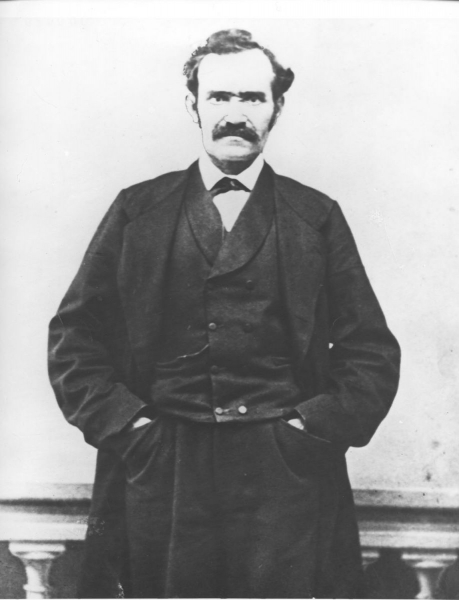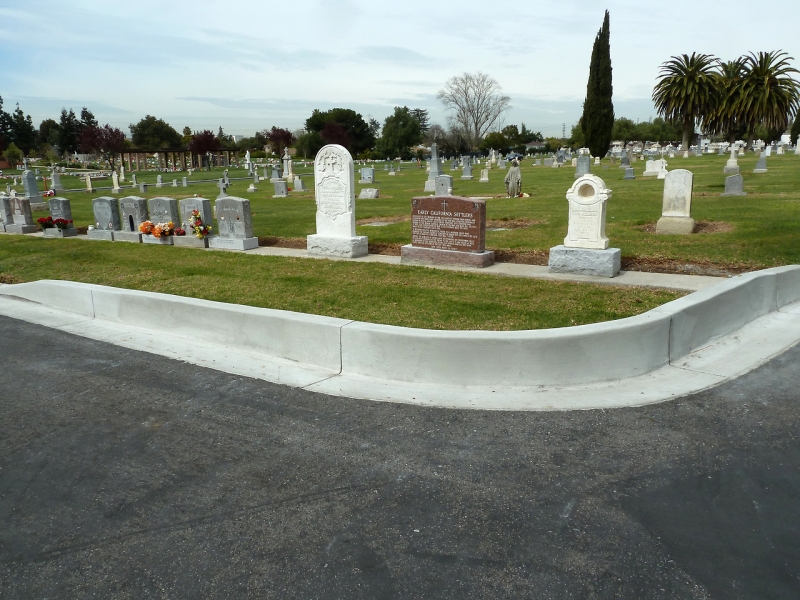
One August day in 2011, a fellow named Tim Peddy came into the California Room to look at some aerial photos. I noticed that one of the aerials showed the San Juan Bautista Hills near my neighborhood. The San Juan Bautista Hills are an outcropping of hills on the southeast corner of Willow Glen that include “The Church on the Hill,” County Communications, Communications Hill (with the cell phone tower), and Oak Hill Cemetery. I pointed out to Tim that the small hill between the church and County Communications had once been part of a Catholic cemetery known as “Kell Cemetery” or “Holy Cross Cemetery.” Then his eyes then widened when I told him that I knew an old farmer who had in his possession the grave marker of Louis Pellier’s nephew.
The older Louis Pellier (1817-1872) was born in St. Hippolyte, France, and came to California during the gold rush. By the early 1850s, he'd opened the City Nursery in downtown San Jose. He was joined a few years later by his brother Pierre. In 1854, Pierre journeyed back to France and returned with a wife, and cuttings and seeds for the nursery. From these, Louis grafted the French prune onto the rootstock of the wild plum, which produced the prune that Santa Clara Valley became famous for.
When Pellier died, he was buried in the Holy Cross cemetery, and was later joined by his nephew (Pierre's son, also named Louis). By the late 1800s, the cemetery was abandoned, with most of the graves reinterred at the Calvary Catholic Cemetery on Alum Rock Avenue. Both Pellier gravestones however, remained at the abandoned cemetery near the small hillside. Louis Pellier’s tombstone was discovered and saved in the 1940s by City Historian Clyde Arbuckle who lived nearby. Later, the smaller tombstone of Pellier’s nephew was saved by Lee Lester who owned adjoining property.
Excited by the news of the nephew’s tombstone, Tim Peddy soon alerted his fellow California Pioneers of Santa Clara County members, who included City Historian Paul Bernal, Jim Zetterquist, Bill Foley, and Rick Helin, also known as the “In Grave Danger Gang.” They were anxious to meet Lee Lester and retrieve the nephew’s tombstone. In the meantime, I contacted Jim Reed with History San Jose, to see if he could locate the tombstone of Louis Pellier that had been saved by Clyde Arbuckle. It was soon located in a History San Jose storehouse, and a plan was made to restore Pellier and his nephew’s tombstones to the site of their reinterment at the Calvary Catholic Cemetery.

Foundations were created, and the markers were placed above the site where the remains of the two Pelliers were buried. A formal dedication took place in October of 2011, with Lee Lester and many Pellier descendants in attendance. All was not well for long though. After more than a century of being separated from the remains of Louis Pellier, the reunited marker was struck and run over by a disoriented driver on the cemetery grounds a few short months later. The “In Grave Danger Gang” didn’t give up however, and the broken marker was eventually repaired and restored, this time with a protective barrier. Whether their tenacity pays off however, only time will tell.

Further Reading in the California Room
- Louis Pellier Nursery Lot by Clyde Arbuckle
- A Century of Pioneers: the California Pelliers Thesis/Project 1970
- Pellier clipping files
- Holy Cross Cemetery clipping files
- Kell Cemetery clipping files


Add a comment to: Looking Back: The Errant Tombstone of Louis Pellier